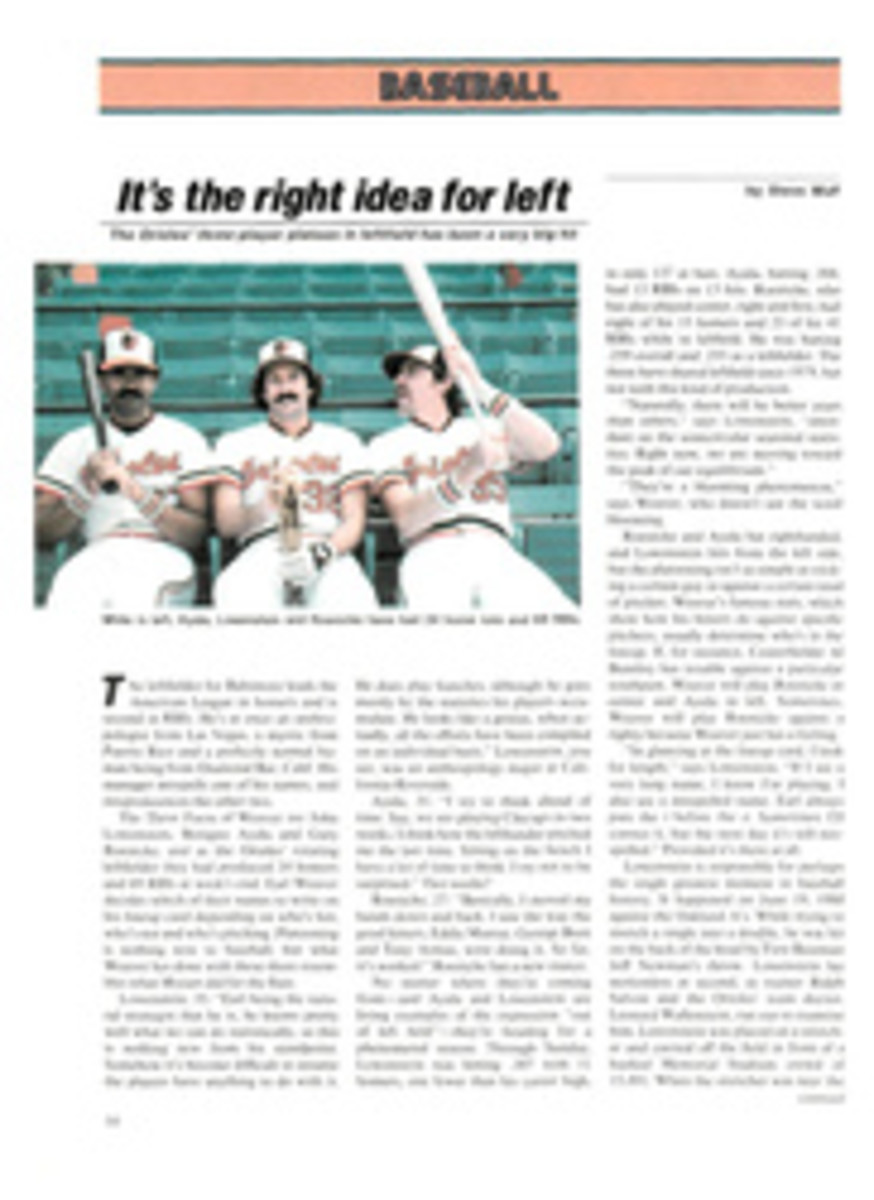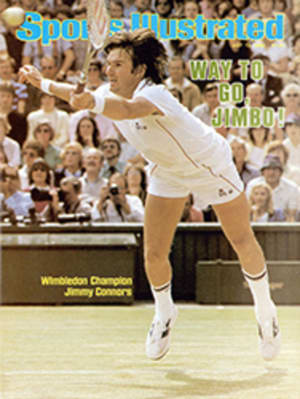
It's the right idea for left
The leftfielder for Baltimore leads the American League in homers and is second in RBIs. He's at once an anthropologist from Las Vegas, a mystic from Puerto Rico and a perfectly normal human being from Diamond Bar, Calif. His manager misspells one of his names, and mispronounces the other two.
The Three Faces of Weaver are John Lowenstein, Benigno Ayala and Gary Roenicke, and as the Orioles' rotating leftfielder they had produced 24 homers and 69 RBIs at week's end. Earl Weaver decides which of their names to write on his lineup card depending on who's hot, who's not and who's pitching. Platooning is nothing new to baseball, but what Weaver has done with these three resembles what Mozart did for the flute.
Lowenstein, 35: "Earl being the natural strategist that he is, he knows pretty well what we can do statistically, so this is nothing new from his standpoint. Somehow it's become difficult to assume the players have anything to do with it. He does play hunches, although he goes mostly by the statistics his players accumulate. He looks like a genius, when actually, all the efforts have been compiled on an individual basis." Lowenstein, you see, was an anthropology major at California-Riverside.
Ayala, 31: "I try to think ahead of time. Say, we are playing Chicago in two weeks. I think how the lefthander pitched me the last time. Sitting on the bench I have a lot of time to think. I try not to be surprised." Two weeks?
Roenicke, 27: "Basically, I moved my hands down and back. I saw the way the good hitters, Eddie Murray, George Brett and Tony Armas, were doing it. So far, it's worked." Roenicke has a new stance.
No matter where they're coming from—and Ayala and Lowenstein are living examples of the expression "out of left field"—they're heading for a phenomenal season. Through Sunday, Lowenstein was hitting .307 with 11 homers, one fewer than his career high, in only 137 at bats. Ayala, batting .304, had 13 RBIs on 13 hits. Roenicke, who has also played center, right and first, had eight of his 15 homers and 23 of his 41 RBIs while in leftfield. He was batting .259 overall and .255 as a leftfielder. The three have shared leftfield since 1979, but not with this kind of production.
"Naturally, there will be better years than others," says Lowenstein, "attendant on the semicircular seasonal statistics. Right now, we are moving toward the peak of our equilibrium."
"They're a blooming phenomenon," says Weaver, who doesn't use the word blooming.
Roenicke and Ayala bat righthanded, and Lowenstein hits from the left side, but the platooning isn't as simple as sticking a certain guy in against a certain kind of pitcher. Weaver's famous stats, which show how his hitters do against specific pitchers, usually determine who's in the lineup. If, for instance, Centerfielder Al Bumbry has trouble against a particular southpaw, Weaver will play Roenicke in center and Ayala in left. Sometimes, Weaver will play Roenicke against a righty because Weaver just has a feeling.
"In glancing at the lineup card, I look for length," says Lowenstein. "If I see a very long name, I know I'm playing. I also see a misspelled name. Earl always puts the i before the e. Sometimes I'll correct it, but the next day it's still misspelled." Provided it's there at all.
Lowenstein is responsible for perhaps the single greatest moment in baseball history. It happened on June 19, 1980 against the Oakland A's. While trying to stretch a single into a double, he was hit on the back of the head by First Baseman Jeff Newman's throw. Lowenstein lay motionless at second, as trainer Ralph Salvon and the Orioles' team doctor, Leonard Wallenstein, ran out to examine him. Lowenstein was placed on a stretcher and carried off the field in front of a hushed Memorial Stadium crowd of 15,491. When the stretcher was near the dugout, Lowenstein rose from the waist and gave a two-fisted salute. The fans went wild. "It was simply an opportunity I could not pass up," he says. Many Orioles now wear a T shirt with a cartoon depicting the moment and the slogan TONIGHT, LET IT BE LOWENSTEIN.
The incident stands as a metaphor for Lowenstein's career. After the '78 season, he was given up for dead by the Texas Rangers and placed on waivers. "I always thought he could play," says Weaver. "He'd hit Jim Palmer hard and then go and make a great catch." Lowenstein plays with the same reckless abandon with which he assaults the English language, banging into walls, getting hit by pitches. Once he stole 36 bases in a season (1974); now he has his doctorate in Weaver's specialty, long ball. "I have run the full gamut of thrills in this game," says Lowenstein. "What's good about the home run is that it tends to immobilize the other team's outfielders."
Lowenstein is into snake hunting, casino management and cakes, the latter literally. Whenever a cake appears in the Orioles clubhouse, he conducts an examination. "If it's from a known source, I leave it alone," he says. "If it's from an unknown source, you never know what viral infections it may be carrying. I give it the finger-plunge test. If it tastes very good, I leave it alone." However, if it fails to meet Lowenstein's strict standards, he takes a specially designed bat to it. "Costs me $5 every time," he says. "That's what I pay the clubhouse man to clean it up." This year he has been treating baseballs as if they were so many Schwarzwälder Kirschtorten.
Ayala is properly pronounced ah-yah-la. Weaver says aye-yell-a. No matter. "He's a pure hitter," says Weaver. "He's so good he knocks himself out of games. I'll start him against a lefthander, and he'll hit a three-run homer off him. Then they'll bring in a righty, and Benny's back on the bench."
Lowenstein maintains that Ayala is the most profound player on the Orioles. "He will sit there, arms folded, for eight innings. If he's going to hit, I'll ask him what he's looking for. He'll say, 'Something white. Coming through.' Sometimes I'll ask him where they'll pitch him. And he'll say, 'Up and away. And in.' I'll say, 'Which is it, up and away or in?' And he'll say, 'Up and away. And in.' "
Orioles still scratch their heads when they recall the time a few of them were in the dugout, talking about a desert movie. In the middle of the conversation, Ayala, who had shown no interest in the discussion, asked, "What is the minimum number of men it takes to safely cross the Sahara Desert?" After a few moments of silence, he answered his own question. "One hundred," he said.
Like Lowenstein, Ayala was given up for lost. After trials with the Mets and Cardinals, he had decided in '79 to go to Japan to play for the Taiyo Whales. But Doc Edwards, his skipper in the Puerto Rican Winter League, talked him into joining Rochester, the Orioles' Triple-A farm club, which Edwards was going to manage. After a fast start, Ayala was called up on April 30, and he's been with Baltimore ever since.
Playing a part-time role, Ayala has barely accumulated a full season's worth of statistics for the Orioles. But in 398 at bats through last week, he had hit 23 homers with 75 RBIs. He would play more, but he's not the best fielder in the world. He knows it and has been working to improve himself. "But it's a difficult situation," he says. "I'm here for my hitting. If I work too hard on my fielding, I might neglect my hitting."
In a May 19 game against Minnesota, Twins Pitcher Pete Filson had a two-strike count on Ayala in the second inning when the umpires ordered play stopped because of rain. After a delay of an hour and 21 minutes, Ayala came to the plate and drilled a three-run homer deep into the seats in left. When asked if he thought he was in a tough spot, having to face a two-strike count after sitting for so long, Ayala replied, "Not really. I just felt like I was pinch-hitting for myself."
Roenicke is pronounced Renn-uh-kee, mispronounced by Weaver as Rye-nuh-kee and shortened by his friends to Rhino. He's an excellent outfielder and one of the streakier hitters in baseball. "It's always been that way," he says. "I hit in bunches, oh for 10, then six for seven."
In his first full season, '79, Roenicke hit a surprising 25 homers. He did it while wearing half of a football face mask on his helmet after being hit below his nose by a pitch from Lerrin LaGrow in the second game of the season. He tried discarding it in 1980, but reconsidered because he found himself "bailing out on everything." He finally got rid of the mask last year. This year he got rid of his upright stance. And with his new style, his slugging percentage of .551 was eighth in the league.
As the leftfielder(s) go, so go the Orioles, who have been rising steadily in the AL East standings, from seventh on May 12 to third on Sunday. "This team is like my tomatoes," says Weaver. "In April and May, they're scrawny little things, barely sticking out of the ground. But by August and September, they could feed the whole blooming world." Weaver has a particularly nice patch in left.
PHOTO
While in left, Ayala, Lowenstein and Roenicke have had 24 home runs and 69 RBIs.

